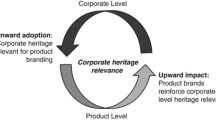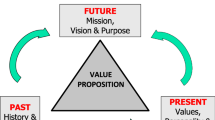Abstract
Existing literature posits that brand heritage engages with the past, present, and future, but it only considers one way of emphasizing that dimension in the positioning. In contrast, this paper considers two distinct positioning strategies based on brand heritage depending on how companies manage temporality. Twenty-five semi-structured interviews are conducted with consumers of brands emphasizing brand heritage. Results show that brand heritage can be based on a worshiped or updated representation of the past. The latter leads to a positioning based on three characteristics: consumer orientation, pioneer spirit, and flexibility. The former leads to a positioning based on five facets: safeguard product orientation, passion over profit, year to year improvement and special occasions. These results contribute to strategic marketing by suggesting two marketing strategies to innovate in manner consistent with tradition. The distinction between two positioning based on brand heritage paves the way for further research on the consequences of its activation. Results also suggest that under certain conditions, market orientation neither leads to innovation nor to incremental developments but rather to a perception of mere status quo.
You have full access to this open access chapter, Download conference paper PDF
Similar content being viewed by others
Keywords
- Strategic Management
- Marketing Strategy
- Market Orientation
- Consumer Orientation
- Customer Relationship Management
These keywords were added by machine and not by the authors. This process is experimental and the keywords may be updated as the learning algorithm improves.
Existing literature posits that brand heritage engages with the past, present, and future, but it only considers one way of emphasizing that dimension in the positioning. In contrast, this paper considers two distinct positioning strategies based on brand heritage depending on how companies manage temporality. Twenty-five semi-structured interviews are conducted with consumers of brands emphasizing brand heritage. Results show that brand heritage can be based on a worshiped or updated representation of the past. The latter leads to a positioning based on three characteristics: consumer orientation, pioneer spirit, and flexibility. The former leads to a positioning based on five facets: safeguard product orientation, passion over profit, year to year improvement and special occasions. These results contribute to strategic marketing by suggesting two marketing strategies to innovate in manner consistent with tradition. The distinction between two positioning based on brand heritage paves the way for further research on the consequences of its activation. Results also suggest that under certain conditions, market orientation neither leads to innovation nor to incremental developments but rather to a perception of mere status quo.
References Available Upon Request
Author information
Authors and Affiliations
Corresponding author
Editor information
Editors and Affiliations
Rights and permissions
Copyright information
© 2017 Academy of Marketing Science
About this paper
Cite this paper
Pecot, F., De Barnier, V. (2017). Strategic Management of Brand Heritage: Two Positioning Perspectives—Abstract. In: Rossi, P. (eds) Marketing at the Confluence between Entertainment and Analytics. Developments in Marketing Science: Proceedings of the Academy of Marketing Science. Springer, Cham. https://doi.org/10.1007/978-3-319-47331-4_15
Download citation
DOI: https://doi.org/10.1007/978-3-319-47331-4_15
Published:
Publisher Name: Springer, Cham
Print ISBN: 978-3-319-47330-7
Online ISBN: 978-3-319-47331-4
eBook Packages: Business and ManagementBusiness and Management (R0)




